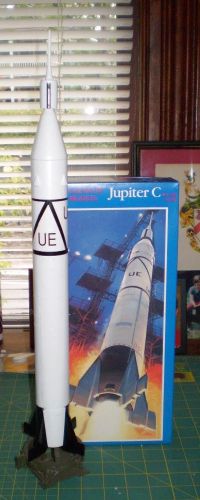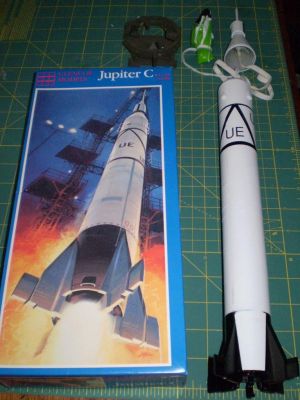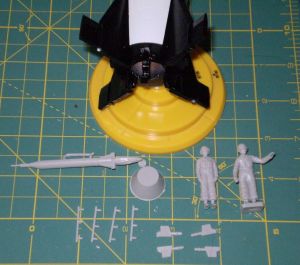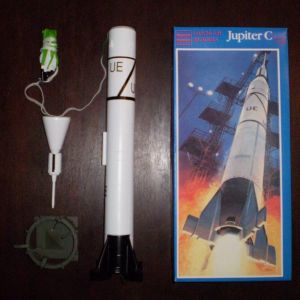
Brief:
I purchased this plastic model kit on eBay for $16 including shipping. This is a great kit to convert to a flying
model rocket using an 18mm mount.
Modifications:
This kit lends itself to a conversion fairly well. In fact this was my first conversion and I found it to be a very
easy build. Anyone who has been building model rockets for a while will have the skill to make this conversion fairly
easily.
I found this Glenco kit to be of good quality. Due to mold degeneration some parts didn't fit exactly, but overall it went together well.
As the previous reviewer mentioned, the diameter of the rocket is close to BT-55 so the 18mm mount and stuffer tube fit inside nicely. I made up a couple of custom made centering rings out of stiff cardboard that I used to secure the mount/stuffer tube assembly. These rings needed to be squared off a bit to allow them to fit inside the tube. The aft ring had to be notched a bit to allow the engine hook to flex. This aft ring also needed to line up with a notch that was made at the bottom of the rocket to allow the engine hook to protrude from the rocket base. This notch was made at the mid point between two fins.
 Of course plastic model cement or epoxy needs to be used on all plastic parts.
Of course plastic model cement or epoxy needs to be used on all plastic parts.
I created an Estes type tri-fold shock cord mount and glued that in about an inch and a half from the top of the main body tube.
Once these few modifications were made, I basically just build the model as per the instructions. I had to remove some material from the inside of the body tube halves, but it wasn't difficult.
I filled the nose cone with (at first too little lead weight--more on that later), and I secured it with epoxy. I embedded a screw eye into the epoxy before it set up.
The nose only has a small lip to sit on. I was tempted to build that up a bit, but since it fit snuggly, I didn't and it worked out fine.
From there I just attached the chute and applied paint and decals.
Note: I left a few of the kit components off of the finished rocket including; four fin extenders that just were too close to the engine for my liking, the engine nozzle that came with the kit (my engine mount looks just fine), and four rail like pieces that I couldn't find any secure way of attaching to the side of the rocket. None of these three things being left off affect the look of the rocket in my opinion.

Construction:
Aside from the plastic kit components I added:
- 1 parachute, shroud lines, tape disks
- 1 small screw eye
- 1 launch lug
- 1 shock cord
- 1 Estes style tri-fold mount
- 3 lead weights for nose cone
- 1 18mm mount
- 2 custom made centering rings
- 1 stuffer tube
Glues used:
- Testors plastic model cement
- 6 minute epoxy
Paint used:
- Painters Touch semi-gloss white
- Painters Touch semi-gloss black
- Wal-Mart brand flat green for rocket base stand
Construction was straightforward and easy. I didn't experience any "gotchas" and the fit and finish are acceptable for a plastic model costing $16.

Flight and Recovery:
Here's where it got interesting. I selected a C6-3 for the first flight. No guts no glory...
She looked great until she reached about 20 feet at which point the model executed the number 4 just like in the Fantastic 4 movie. It took a sharp angle dive towards the ground then executed a sharp turn that put it on a horizontal course about 10 feet off the ground. The engine burned out and it dropped to the ground before ejection. Since I had launched in thick grass and this thing has a tough plastic exterior, there was no damage at all, not even a scratch. It was also a heads-up launch so no spectators were anywhere near the fun. Everyone in attendance had a good laugh at the maiden flight.
The problem of course is that I hadn't added enough nose weight and the flight was completely unstable. It was actually one of the more entertaining flights I have ever seen.
Since that first flight I added two thirds more nose weight and it now gives a respectable flight on a C6-3 engine, but that first flight was one to remember. I haven't flown this on anything other than a C6-3.
Summary:
I got a lot of satisfaction out of converting this plastic model to a flying rocket. If you are looking for something
a bit different a PMC conversion may just be the ticket. Just be sure to take more time than I did to figure out the CG
and add the appropriate nose weight before the first flight.
Sponsored Ads
 |
 |











